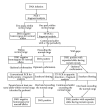Molecular genetics and genetic testing in myotonic dystrophy type 1
- PMID: 23586035
- PMCID: PMC3613064
- DOI: 10.1155/2013/391821
Molecular genetics and genetic testing in myotonic dystrophy type 1
Abstract
Myotonic dystrophy type 1 (DM1) is the most common adult onset muscular dystrophy, presenting as a multisystemic disorder with extremely variable clinical manifestation, from asymptomatic adults to severely affected neonates. A striking anticipation and parental-gender effect upon transmission are distinguishing genetic features in DM1 pedigrees. It is an autosomal dominant hereditary disease associated with an unstable expansion of CTG repeats in the 3'-UTR of the DMPK gene, with the number of repeats ranging from 50 to several thousand. The number of CTG repeats broadly correlates with both the age-at-onset and overall severity of the disease. Expanded DM1 alleles are characterized by a remarkable expansion-biased and gender-specific germline instability, and tissue-specific, expansion-biased, age-dependent, and individual-specific somatic instability. Mutational dynamics in male and female germline account for observed anticipation and parental-gender effect in DM1 pedigrees, while mutational dynamics in somatic tissues contribute toward the tissue-specificity and progressive nature of the disease. Genetic test is routinely used in diagnostic procedure for DM1 for symptomatic, asymptomatic, and prenatal testing, accompanied with appropriate genetic counseling and, as recommended, without predictive information about the disease course. We review molecular genetics of DM1 with focus on those issues important for genetic testing and counseling.
Figures

References
-
- Steinert H. Uber das klinishe und anatomische bild des muskelschwundes der myotoniker. Deutsche Zeitschrift für Nervenheilkunde. 1909;37:p. 38.
-
- Harper PS. Myotonic Dystrophy. 3rd edition. London, UK: WB Saunders; 2001.
-
- Harley HG, Brook JD, Rundle SA, et al. Expansion of an unstable DNA region and phenotypic variation in myotonic dystrophy. Nature. 1992;355(6360):545–547. - PubMed
-
- Fleischer B. Über myotonische dystrophie mit katarakt. Albrecht von Græfes Archiv für Ophthalmologie. 1918;96(1-2):91–133.
Publication types
MeSH terms
Substances
LinkOut - more resources
Full Text Sources
Other Literature Sources
Medical

